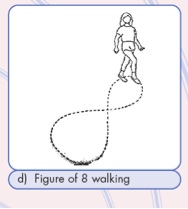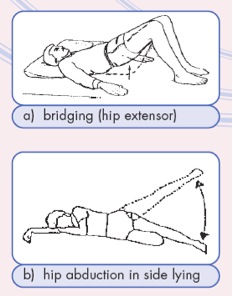Falls prevention
A CGH nurse who contributed some tips in a booklet shares how to prevent falls at home and how to keep it at bay.
BY: Eleanor Yap
 Falls can be common as one ages. As Singapore faces a growing ageing society, the number of falls is likely to increase. Senior Staff Nurse Saraswathi d/o Vaiyapun from Changi General Hospital (CGH), who contributed some tips to a booklet on fall prevention called “Steady, Stable and Safe – An overview of fall prevention”. The booklet, which was launched in late July in conjunction with Nurses Day, will help patients and share knowledge amongst healthcare professionals to better serve patients.
Falls can be common as one ages. As Singapore faces a growing ageing society, the number of falls is likely to increase. Senior Staff Nurse Saraswathi d/o Vaiyapun from Changi General Hospital (CGH), who contributed some tips to a booklet on fall prevention called “Steady, Stable and Safe – An overview of fall prevention”. The booklet, which was launched in late July in conjunction with Nurses Day, will help patients and share knowledge amongst healthcare professionals to better serve patients.
Agelessonline speaks to Saraswathi on what we need to be aware of:
Can you share some recent statistics on seniors falling in homes?
The prevalence of elderly falls in a community setting in Singapore was 17.2 percent according a local study done in 1997 (KM Chan, 1997). In a recent study on The Singapore Malay eye study by Ecosse L. Lamoreux et al. (2008), 14.7 percent of subjects with age of 40 to 80 years reported having fallen in the past 12 months.
Although falls are rarely a direct cause of mortality, death occurs as a result of complication of a fall, e.g. brain injury. The mortality from falls increases with age.
With a growing ageing population, what do you see happening?
American studies shown that more than 1/3 of adults aged 65 and above fall every year. With a growing ageing population, there will be more elderly falling in the community or the hospital.
Why do seniors fall and are of higher risk of falling and suffering injuries?
The biological changes of ageing do contribute a general decline in the elderly, such as poor eyesight and hearing. Illness and physical conditions can also affect elderly’s gait and balance. Side effects of the medication, such as giddiness and drowsiness, can also increase risk of falling. Thin bones, coupled with the problems listed above, and decreased ability to break the fall put the elderly at higher risk of injury after a fall.
The causes of elderly falling are always multifactorial, patient health problem, environmental hazards, behavioural and social factors.
In the booklet, there is a part on the link between exercise and reduced fall risk. Can you explain more and what types of specific exercises would help?
Regular exercise can help to maintain strength and decrease the loss of bone density; but not all exercises contribute equally towards fall prevention. An effective fall prevention exercise programme should focus on the strength of the lower limbs, balance and general endurance.
Exercises that strengthen the major muscles in the legs ensure that the legs can support the weight of the rest of the body. Certain types of exercise, like tai chi and yoga, improve balance and can build an elderly person’s confidence when walking and climbing stairs.
For endurance training, walking seems the natural choice. Endurance is important because it means being able to perform certain tasks for a longer time without getting weak or tired.
Here are some practical exercises for:
Strength training – The major muscles of the legs are targeted, as these are essential for movement and transfers. You may wish to try these out:
These can be done at two sets of 10 repetitions with 10-second hold for each repetition. Ankle weights can be added to provide resistance to the muscles. It is recommended to perform these exercises two to three times per week.
Balance training – Balance exercises should be done in dynamic form rather than static to be effective. Hence, if you are not confident in performing them, do have an assistant with you. Start by holding onto stable supports (e.g. the window or dining table). As you improve, you may omit hand support.


These can be done in three to four repeats of 10 steps each, three times per week.
Endurance training – Walking is the easiest form of endurance exercise for the elderly. It is recommended to begin walking for 20 to 30 minutes a day at one’s usual pace. The duration and speed can be increased over time as the person gets accustomed to this activity.
To improve effectiveness, the exercise programme should be specific to address the person’s physical problem. Exercises should also be progressed over time to challenge the body. The above exercises are only suggestions, which can be easily performed at home. Do consult a physiotherapist for assessment and exercise programme if in doubt.
What are some tips for caregivers to think about when caring for a senior and preventing a fall?
- Involve elderly in physical activities such as walking to improve strength, balance, coordination and flexibility.
- Wear appropriate footwear: Proper fitting, sturdy shoes with non-skid soles.
- Remove home hazards, such as loose rugs, electrical cords and wires, and use non-slip mats in bathroom.
- Keep home brightly lit, place nightlights in bedroom, bathroom and hallways.
- Use assistive devices to keep the elderly steady, such as grab bars and plastic seat in shower room.
Are there some tips that homeowners can keep in mind to prevent falls in their home?
1) Understand own medical problems and side effects of the medications taken.
2) Be involved in physical activities such as walking to improve strength, balance, coordination and flexibility.
3) Wear appropriate footwear: Proper fitting, sturdy shoes with non-skid soles.
4) Remove home hazards, such as loose rugs, electrical cords and wires, and use non-slip mats in bathroom.
5) Keep home brightly lit, place night lights in bedroom, bathroom and hallways
6) Use assistive devices to keep the elderly steady, such as grab bars and plastic seat in shower room.
What about recent statistics on seniors falling in hospitals? Specially SingHealth Group? Has it increased from the previous year? Why do they fall?
With the increasing ageing population in Singapore, hospitals are expecting to see an increase admission of the elderly. Research has shown that falls increases with age, therefore hospitals have to be more proactive in coming up with fall prevention initiatives.
SingHealth cluster comprises of tertiary hospital, acute and specialty centres, therefore more complex elderly patients will be treated in these hospitals.
There are many reasons why the elderly fall. We see biological changes in the elderly such as failing eyesight due to diabetes, osteoporosis that affect the bones causing them to be brittle and frail, illness that may affect the gait and balance in the elderly. The mere fact that they are out of their familiar home environment and in the hospital, the elderly becomes disorientated and will take time to adapt to the surroundings. It is made worse when they are suffering from dementia.
You mentioned in one part of the booklet about more than one hospital in the SingHealth Group has observed that the incidence of patient falls is higher at night. Can you elaborate?
It is known that the elderly are light sleepers and usually sleep for a few hours at night. When they are wake, many of them attempt to go to the toilet by themselves without asking for assistance. Data showed that many of the falls at night occur when patients are making their way to or from the toilet, or when using toilet facilities such as the bedside commode or urinal. As a result, many procedures have been changed or created to prevent falls when patients go to answer the call of nature. At all SingHealth hospitals, nursing rounds are done every two to three hours so that nurses can see to the needs of patients. Nurses have also check on the toileting needs of patients who awaken and sit up during those hours of the night when rounds are not scheduled.
How has SingHealth curbed the incidences? Through safer-assisted bathrooms and commode chair designs?
There are many initiatives in place to reduce and prevent patient falls in the hospitals. Most of the interventions address:
– Environmental modifications e.g. leveling of walking surfaces, patients to wear non-slip slippers, installation of anti-slip flooring in and around the outside of toilets, support rails and bars installed in bathrooms and toilets, and along corridors, stairways and slopes, call bells fitted next to the sink and in the toilet corridor outside individual cubicles for patients’ greater ease and convenience, Installing night lights in wards near patients’ beds for patients to better see where they are walking.
– Regulation of ambulation e.g. pedal bins in patient areas replaced with open bins, wheelchairs, commode chairs and “over-bed” tables have been installed with additional stabilizers and wheel-locks, age-friendly chairs with armrests to provide support to patients when rising from a seated position, lower height of the beds.
– Toileting e.g. geriatric commode chairs, grab bars installed in the bathrooms, and wheel clamp to secure the commode-shower chairs and prevent slippage.
After a fall, what treatment is usually given?
The first thing to do with the patient is to assess his or her condition. Determine if there are any serious injuries. These should be treated immediately. If there are no serious injuries, the patient should be helped to a chair or a bed. Minor injuries such as cuts, lacerations and bruises should be treated accordingly or investigated as necessary.
The patient can be referred for therapy following a fall. The physiotherapist will conduct a detailed evaluation of the patient before developing a treatment plan. It is to help the patient regain as much as possible his or her ability and confidence to perform all the tasks that he or she used to do before suffering another fall.
** Singapore General Hospital has a falls clinic, which opened in December last year and will have a multi-disciplinary team.
(PHOTO COURTESY: Elderly picture by SingHealth Academy. Also special thanks to Serene Ng from Singapore Health Services.)



0 Comments